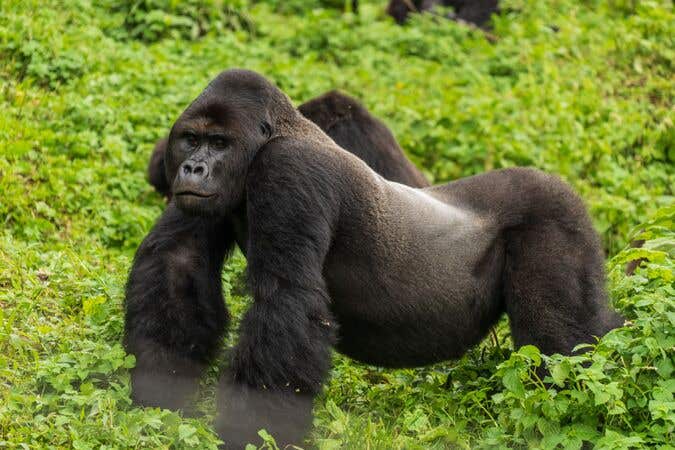Stolen from his family as a baby, Kighoma was held captive by an armed militia in the Democratic Republic of the Congo (DRC). Until his rescue, this tiny gorilla was kept as a ‘mascot,’ serving as a status symbol for the rebel group. Unlike most illegally captured young gorillas, Kighoma managed to survive. It is estimated that for every captured baby gorilla, three or more of their family members are killed in the process. After being rescued, Kighoma spent several years living in a temporary care center while the world’s first and only sanctuary for Eastern Lowland Gorillas was being constructed. Located adjacent to the Tayna Nature Reserve, the Gorilla Rehabilitation and Conservation Education Center (GRACE Gorillas) is now home to 14 rescued Eastern Lowland Gorillas.
"Eastern Lowland Gorillas are under severe threat from instability, poaching, mining, conflict and deforestation,” says Jackson Kabuyaya Mbeke, GRACE DRC director. “This has led to an increase in the illegal trade of young gorillas. GRACE started because we needed a long-term solution for orphaned Eastern Lowland Gorillas. The goal is to rehabilitate them and eventually reintroduce them into the wild. The community in eastern DRC is the future for Eastern Lowland Gorillas."
Today, these rescued Eastern Lowland Gorillas have been integrated into a healthy and thriving family group at GRACE. Kighoma has now matured into a dominant silverback gorilla and confidently leads the group of rescued gorillas at GRACE. His caregivers refer to him as a gentle but effective leader, always looking out for the safety of the other gorillas. Kighoma’s story serves as a reminder of the vital work that GRACE Gorillas does to ensure that Eastern Lowland Gorillas are protected and can thrive in the forests of the DRC.
Protecting the future of Eastern Lowland Gorillas
Endemic to the eastern DRC, only 20% of the original Eastern Lowland Gorilla (also known as Grauer’s Gorilla) population remains. Habitat loss, mining, disease, and poaching have all contributed to the decline of these primates, which are classified by the International Union for Conservation of Nature’s (IUCN) Red List as Critically Endangered. But one organization in particular has set out to work alongside Congolese communities to promote the conservation of Eastern Lowland Gorillas and their habitat, ensuring a bright future for these apes.
“We are thrilled to collaborate with GRACE Gorillas in protecting Eastern Lowland Gorillas in the DRC,” says Mary Brown, Re:wild senior manager of Africa program and conservation partnerships. “Their work acts as a lifeboat for these Critically Endangered primates. Their model of working hand-in-hand with local communities offers an ‘oasis of hope’ that we hope to see replicated for other species in need.”
GRACE Gorillas has put community at the heart of its mission since its founding over a decade ago. GRACE’s sprawling Eastern Lowland Gorilla sanctuary was built on land donated by the local community, with the blessing of two traditional kings (called Mwamis). Highly respected cultural leaders in DRC, the Mwamis continue to partner with and help guide GRACE today. Internationally recognized for its excellence in gorilla care, the GRACE sanctuary laid the foundation for the organization’s education, engagement, and conservation programs, which reach thousands of Congolese residents each year. From growing food for the 14 rescued gorillas at the sanctuary, to teaching primary school students about gorillas and forests, GRACE does everything hand-in-hand with the surrounding communities.
Recovery to sanctuary
“Upon arrival we assign a caregiver to each new orphan, someone who plays the role of a parent to the baby so we can help rebuild the baby’s confidence. When the baby feels, ‘Ah, ok, I found my guardian,’ that’s when we move to the next step: getting to know the other gorillas here at GRACE,” explains Mbeke. “Our dream is for no more orphans to arrive at GRACE, a future where these gorillas are thriving in the wild without any threats.”
The rehabilitation process for these gorillas is both physical and emotional, as they recover from the stress and trauma of losing their families. GRACE is committed to ensuring a smooth recovery for each individual rescued gorilla, providing them formula and round-the-clock care when they first arrive. As soon as they are ready, rescued gorillas are integrated into the larger gorilla group, where they continue to learn the skills required for survival in the wild. Rehabilitation is a critical first step towards GRACE's overall goal of rewilding these Eastern Lowland Gorilla orphans to prevent their extinction in eastern DRC.
GRACE is proud to be accredited by the Global Federation of Animal Sanctuaries (GFAS), a testament to the dedicated caregivers who work tirelessly to ensure these gorillas receive the utmost excellent care and welfare.
“Caring for gorillas means providing a second chance at life for these orphaned babies, and rehabilitating them after the stresses of being separated from their families,” says Dalmas Kakule Syangeha, GRACE animal care manager. “Our days might be long and the work can be difficult, but we are proud of the importance of our role. We are conserving gorillas for future generations, so that people may have the chance to see this species.”
The gorillas at GRACE spend their days in a large, natural forest habitat, where they forage for food, climb, play, build nests, and rest together. To ensure each gorilla receives proper nutrition, their forest diet is supplemented with vegetation grown on a special food farm at GRACE. Beet root, carrot, elephant grass, and passion fruit are some of the gorillas’ favorite treats.
Thriving community partnership
"In order for conservation to be successful, we need to work hand in hand with the local community to develop solutions that improve both human and gorilla welfare for both the present and future generations," says Mbeke.
Through GRACE Gorillas’ partnership with Réserve des Gorilles de Tayna (RGT), over 47 local community members have been hired and trained for gorilla protection and monitoring in Tayna Nature Reserve. Significant data on gorilla diet, group size, composition, and behavior, as well as information on potential threats to gorillas, their habitat, and other wildlife species in the region, have been gathered by the monitoring and protection teams. This community-led biomonitoring program ensures that 222,3948 acres of primary tropical forest remain protected for Eastern Lowland Gorillas. GRACE is now working with Congolese and international partners to extend this important gorilla habitat to an area of over 500,000 acres through community-led conservation designed to benefit both people and wildlife.
“GRACE works hard to understand the underlying drivers of the threats facing Eastern Lowland Gorillas, and to implement solutions addressing both wildlife and human needs,” says Katie Fawcett, GRACE program director. “For example, we have worked with women's groups on projects that will support fuel-efficient stoves, which will reduce the need to enter the forest to collect firewood and also improve the health of the people who are cooking.”
GRACE educators, who have strong roots in the local community, engage more than 30,000 people in conservation education each year. With a focus on community empowerment, they lead school programs, youth conservation clubs, sustainable livelihood workshops, tree plantings, special events, and radio broadcasts. GRACE educators strive to foster empathy, raise awareness about gorilla protection, and co-create sustainable conservation solutions that benefit people and wildlife.
Ultimately, GRACE Gorillas seeks to promote a peaceful coexistence where people and gorillas thrive. As Jackson Kabuyaya Mbeke says, “Eastern Lowland Gorillas have always been a part of our community. Protecting them brings a great source of pride for us all.”
Eddy Daniel is an environmental toxicologist and writer who is passionate about the environment and health. As an environmental writer, she writes to create awareness on environmental issues and tells stories of people and the work they do to protect the environment.




